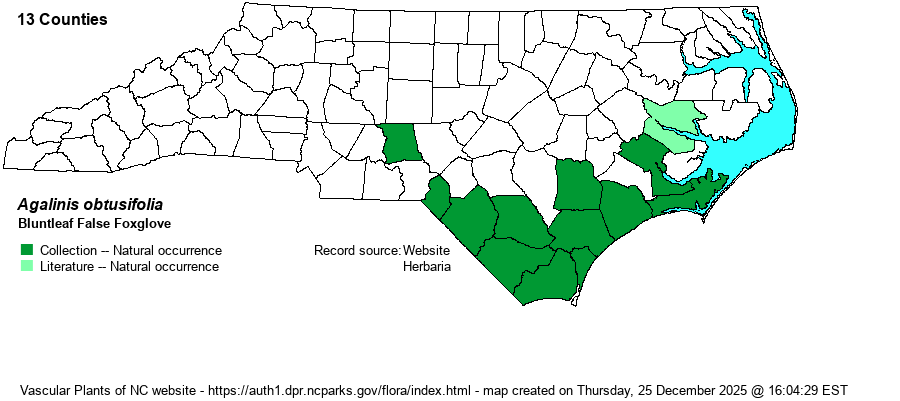| Author | Rafinesque | |
| Distribution | Known for certain in the southern third of the Coastal Plain, north to Beaufort County (Voice of America Game Land) and to Scotland County, with a disjunct record from Montgomery County in the adjacent southern Piedmont (specimens from 2009 at Pleasant Grove Longleaf site and from 2021 at Lomax Longleaf site). Owing to confusion with the similar A. decemloba, several specimens reported as A. obtusifolia from farther north in the Piedmont (i.e. Durham and Guilford Counties), and from Johnston County in upper Coastal Plain, as not included by the website editors on this map, owing to questionable habitats reported on the specimen labels. The Digital Atlas of Virginia Flora includes quite a few records from eastern VA, but the text does suggest that many or most of those may refer to A. decemloba. Similarly, online specimens from Harnett and Moore counties (at ODU) appear to be A. setacea. Thus, how far north in NC A. obtusifolia extends on the Coastal Plain is quite unsettled right now.
This species' range is unsettled. It apparently ranges north to DE and south to southern FL and west to eastern LA. Weakley (2018) says it also occurs in TN.
| |
| Abundance | Infrequent to locally fairly common, at least in natural areas dominated by Longleaf Pine (Pinus palustris) savannas and flatwoods in coastal counties. Relatively rare to uncommon farther westward to Scotland County, and very rare in the southeastern Piedmont. Though the NCNHP considers this as a Watch List species, it is numerous enough to removed from that list. | |
| Habitat | This is a species of pine flatwoods and drier parts of pine savannas. It can also occur in seepages in pine forests, including at the sites in Montgomery County. Several references mention "disturbed areas" and "waste places", but occurrences at such ruderal sites must be very low in NC; perhaps they refer to grassy roadsides or powerline clearings, as most NC sites are in reasonably high quality places. |
| Phenology | Blooms in September and October, and fruits in October and November. | |
| Identification | This is a rather small and slightly bushy herb, growing to about 1 foot tall. The branches from the upper parts of the stem are mostly ascending and rather stiff. The numerous opposite leaves are nearly linear, only about 2/5-inch long, but tend to be slightly wider toward the tip and slightly rounded at the tip. The racemes at the ends of the branches contain a few flowers each, with each flower being pink in color and about 1/2-inch long and across at the face. In this species, there are no yellow lines in the throat; the very similar and essentially Piedmont and Sandhills species A. decemloba has two yellow lines inside the throat. The 5 lobes in A. obtusifolia can also have slight concave tips to look slightly 10-lobed, like the other species, so this character is not useful in separation. The other two separation features are that A. decemloba has leaves that taper to acute or acuminate (sharp) tips, and it has branches that are essentially smooth to the touch, as opposed to scabrous in A. obtusifolia. Other Agalinis species of Coastal Plain savannas and other grasslands have larger and/or brighter rose flowers and longer leaves. Note also that A. tenella, which has long been ascribed to southeastern NC (as in RAB 1968), is now considered by Weakley (2018) and one of the website editors (Sorrie) to not occur as far north as NC, but only north to southern SC. | |
| Taxonomic Comments | A few references consider this species and A. decemloba as the same species, though most do not.
| |
| Other Common Name(s) | Oddly, many references use the name Tenlobe False Foxglove, which is the common name associated with A. decemloba! Note that obtusifolia means "blunt leaf". | |
| State Rank | S3 | |
| Global Rank | G4 | |
| State Status | W1 | |
| US Status | | |
| USACE-agcp | FAC link |
| USACE-emp | FACU link |

